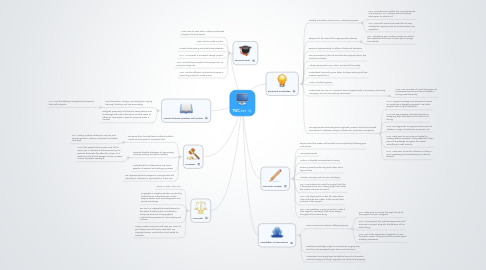
1. Critical Thinking, Reading, and Writing
1.1. Use information, writing, and reading for inquiry, learning, thinking, and communicating
1.1.1. CH 2. use the different emphasis techniques to help with projects.
1.2. Integrate previously held beliefs, assumptions, and knowledge with new information and the ideas of others to accomplish a specific purpose within a context
2. Processes
2.1. Be aware that it usually takes multiple drafts to create and complete a successful text
2.1.1. CH1. having multiple drafts you can pick and choose pieces to make an complete and better final draft
2.2. Develop flexible strategies for generating, revising, editing, and proof-reading
2.2.1. CH3 If the page looks too plain and all the same, put in contrast in the words and put in pictures that make the attention drawn to it. Redo any and all bad designs to help increase chance of people reading it.
2.3. Understand the collaborative and social aspects of research and writing processes
2.4. Use appropriate technologies to manage data and information collected or generated for future use
3. Personal Goals
3.1. Learn how to work with multiple multimedia programs to do projects.
3.2. Learn how to make a video
3.3. Master bookmarking and publishing websites
3.4. CH1. Accomplish a successful design project
3.5. CH2. Include the principles of emphasis into my projects, blogs, etc.
3.6. CH3. Use the different contrast techniques in upcoming project to make it pop.
4. Copyright
4.1. DON'T MESS WITH IT!!!
4.2. Copyright is a legal protection granted by federal law to individuals who create original works, such as photographs and sound recordings.
4.3. Fair use is a copyright principle based on the belief that the public is entitled to freely use portions of copyrighted materials for purposes of commentary and criticism
4.4. Using Creative commons will help you cover all your bases and not have to deal with any copyright issues. Good site to find media for example.
5. Rhetorical Knowledge
5.1. Identify, articulate, and focus on a defined purpose
5.1.1. CH4. Use balance to define the correct purpose of a project or ad. Add symmetrical balance techniques to enhance it.
5.1.2. CH7. Use both verbal and visual flow to help identify the right purpose and narrow down any questions.
5.2. Respond to the need of the appropriate audience
5.2.1. CH1. identifying your audience helps you attract their attention and communicate your message successfully
5.3. Respond appropriately to different rhetorical situations
5.4. Use conventions of format and structure appropriate to the rhetorical situation
5.5. Adopt appropriate voice, tone, and level of formality
5.6. Understand how each genre helps to shape writing and how readers respond to it
5.7. Write in multiple genres
5.8. Understand the role of a variety of technologies/media in accessing, retrieving, managing, and communicating information
5.8.1. CH2. Use a number of visual techniques to emphasize key elements and establish a strong visual hierarchy.
5.9. Use appropriate technologies to organize, present, and communicate information to address a range of audiences, purposes, and genres
5.9.1. CH 2. using technology and examples to focus on emphasis in designing projects. Use other peoples work to get inspiration.
5.9.2. CH3 Use eye popping contrast examples in designing web instructions and make it not boring.
5.9.3. CH5. Use alignment to organize information to address a range of audiences, purposes, etc.
5.9.4. CH6. Make sure to use unity and gestalt in making different projects. Using repetition helps pop out the design and gives the viewer something to refer back to.
5.9.5. CH7. Make sure to use the influence of flow in your organizing and presenting your ideas to people.
6. Knowledge of Conventions
6.1. Learn common formats for different genres
6.1.1. CH1, make sure to choose the right format for the project that your assigned
6.1.2. CH4. Choosing the the right background and all elements in project play into the balance of the whole thing.
6.1.3. CH6. Use all the elements of repetition in your formats to make it flow well and the viewer given a lasting impression.
